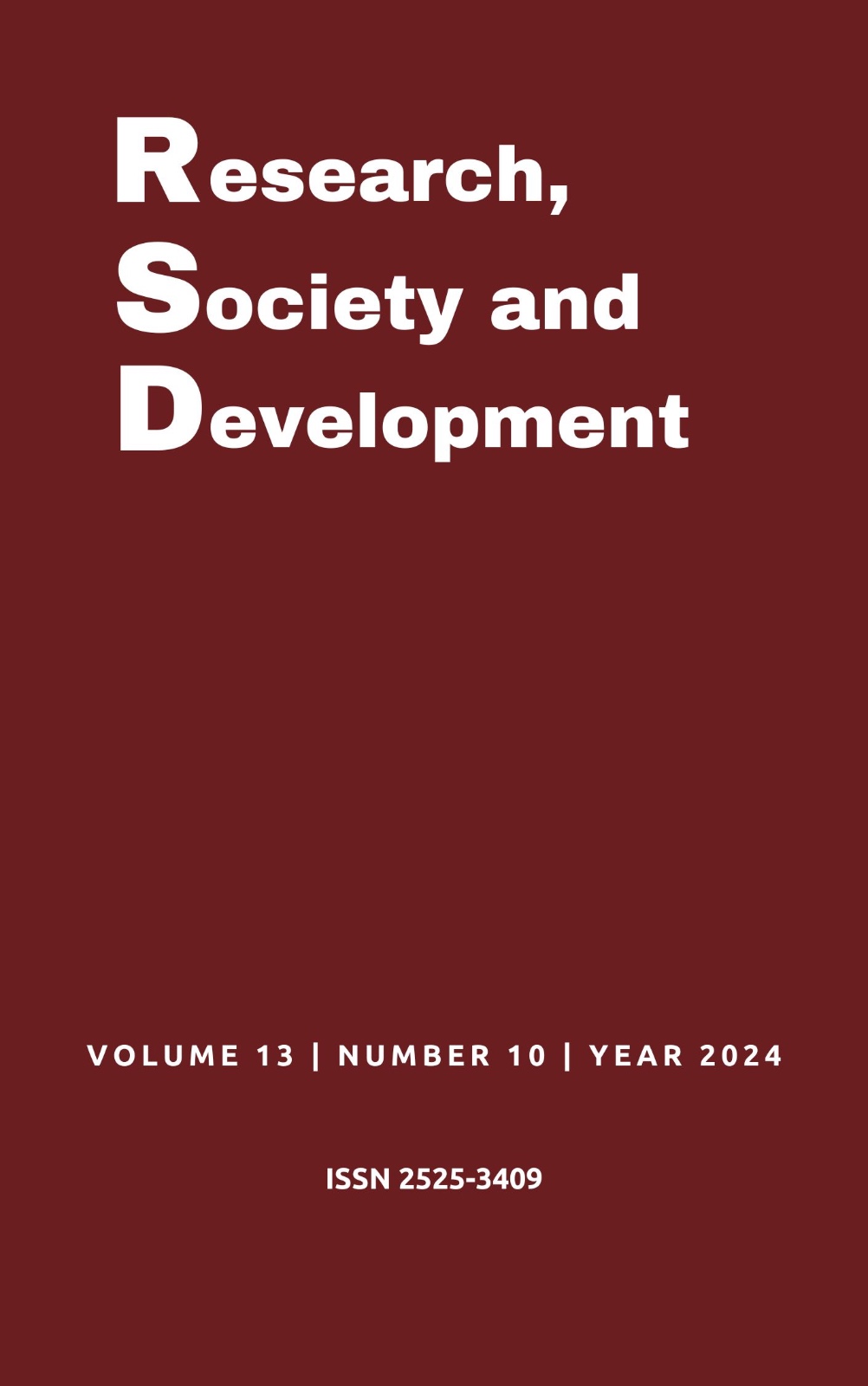The influence of risk factors on the outcome of peripheral arterial obstructive disease: An epidemiological study on the prognosis of patients admitted to a tertiary public hospital in Aracaju
DOI:
https://doi.org/10.33448/rsd-v13i10.47240Keywords:
Peripheral arterial occlusive disease, Risk factors, Prognosis.Abstract
Peripheral arterial occlusive disease (PAOD) or peripheral arterial disease (PAD) is a pathology that results from the concentration of atheromatous plaques in the arteries, especially in the lower limbs. The disease is influenced by numerous risk factors, such as diabetes mellitus, atherosclerosis, arterial hypertension, chronic kidney disease and smoking. The objective of this study is to analyze the influence of risk factors on the clinical and surgical outcome of peripheral arterial occlusive disease. To carry out the study, the research methods epidemiological analysis and literature review were combined. Regarding the literature review, 25 articles were selected, in English, Portuguese and Spanish, using the PubMed, Scielo, LILACS and UptoDate databases. The research was conducted based on the descriptors “peripheral arterial disease”, “diabetes”, “atherosclerosis”, “smoking”, “chronic kidney disease”, “prognosis” and “hypertension”. In the epidemiological analysis, the medical records of 333 patients with PAOD admitted to the Vascular Surgery Department of the Federação Beneficente Hospital Cirurgia in Aracaju, Sergipe, and undergoing treatment at the institution were analyzed. Based on the correlation between the results found, the influence of the risk factors studied on the development and outcome of the disease became clear, as well as on the viable treatment possibilities according to the comorbidity analyzed. Furthermore, it was evident that greater primary control of risk factors can prevent greater future complications in the course of the disease.
Downloads
References
Barnes, Eid, Creager & Goodney. (2020). Epidemiology and Risk of Amputation in Patients With Diabetes Mellitus and Peripheral Artery Disease. https://pubmed.ncbi.nlm.nih.gov/32580632/
Basile & Bloch. (2024). Overview of hypertension in adults. https://www.uptodate.com/contents/overview-of-hypertension-in-adults?search=hipertensao&source=search_result&selectedTitle=1~150&usage_type=default&display_rank=1#H8
Berger & Davies. (2023). Overview of lower extremity peripheral artery disease.
https://www.uptodate.com/contents/overview-of-lower-extremity-peripheral-artery-disease?search=doen%C3%A7a%20arterial%20perif%C3% A9rica&sourc e=search_result&selectedTitle=3~150&usage_type=default&display_rank=3#H78322284
Bloch & Basile. (2023). Cardiovascular risks of hypertension.
Bosevski, M. (2017). Peripheral Arterial Disease and Chronic Kidney Disease. https://sciendo.com/article/10.1515/prilozi-2017-0019
Cerqueira, O. L., et al. (2019). Classificação WifI: o novo sistema de classificação da Society for Vascular Surgery para membros inferiores ameaçados, uma revisão de literatura. https://www.scielo.br/j/jvb/a/sryZZMwM6kySTg4Xkgsr8rz/?format=pdf
Conte, S. M., et al. (2019). Global vascular guidelines on the management of chronic limb-threatening ischemia. https://pubmed.ncbi.nlm.nih.gov/31159978/
Egan. (2024). The prevalence and control of hypertension in adults.
Ettehad, D., et al. (2015). Blood pressure lowering for prevention of cardiovascular disease and death: a systematic review and meta-analysis. https://www.thelancet.com/journals/lancet/article/PIIS0140-6736(15)01225-8/fulltext
Firnhaber & Powell. (2019). Lower Extremity Peripheral Artery Disease: Diagnosis and Treatment. https://pubmed.ncbi.nlm.nih.gov/30874413/
Inzucchi & Lupsa. (2023). UpToDate. Clinical presentation, diagnosis, and initial evaluation of diabetes mellitus in adults. https://www.uptodate.com/contents/clinical-presentation-diagnosis-and-initial-evaluation-of-diabetes-mellitus-in-adults?search=diabetes&topicRef=1810& source=see_link#H1
Jackson. (2022). Cardiovascular risk of smoking and benefits of smoking cessation. https://www.uptodate.com/contents/cardiovascular-risk-of-smoking-and-benefits-of-smoking-cessation?search=tabagismo&source=search_result&selectedTitle=4%7E150&usage_type=default&display_rank=4#H1
Kaski. (2023). Pathogenesis of atherosclerosis. https://www.uptodate.com/contents/pathogenesis-of-atherosclerosis?search=doen%C3%A7a%20arterial%2 0perif%C3%A9rica&topicRef=95282& source=see_ link#H11408436
Krishna, M. S., Moxon, V. J. & Golledge, J. (2015). A review of the pathophysiology and potential biomarkers for peripheral artery disease. https://pubmed.ncbi.nlm.nih.gov/25993296/
Levey & Inker. (2024). Definition and staging of chronic kidney disease in adults https://www.uptodate.com/contents/definition-and-staging-of-chronic-kidney-disease-in-adults?search=doen%C3%A7a%20renal%20cronica&topicRef=7172&source=see_link
London, M. G. (2018). Arterial Stiffness in Chronic Kidney Disease and End-Stage Renal Disease https://karger.com/bpu/article/45/1-3/154/329496/Arterial-Stiffness-in-Chronic-Kidney-Disease-and
Martin. (2024). Diabetic neuroarthropathy. https://www.uptodate.com/contents/diabetic-neuroarthropathy?search=hordon&source=search_ result&selectedTitle=5%7E5&usage_type=default&display_rank=5
Neschis & Golden. (2024). Lower extremity peripheral artery disease: clinical features and diagnosis.
Nordanstig, J., et al. (2023). Peripheral arterial disease (PAD) – A challenging manifestation of atherosclerosis. https://pubmed.ncbi.nlm.nih.gov/37031910/
Pereira A. S. et al. (2018). Metodologia da pesquisa científica. [free e-book]. Santa Maria/RS. Ed. UAB/NTE/UFSM.
Radic, J. et al. (2024). Is Arterial Stiffness Interconnected with Cardiovascular Drug Prescription Patterns, Body Composition Parameters, and the Quality of Blood Pressure Regulation in Hypertensive Patients? https://pmc.ncbi.nlm.nih.gov/articles/PMC11429216/
Rigotti. (2024). Benefits and consequences of smoking cessation. https://www.uptodate.com/contents/benefits-and-consequences-of-smoking-cessation?search=tabagismo&source=search_result&selectedTitle=2%7E150&usage_type=default&display_rank=2#topicContent
Robertson & Ulder. (2024). Pathogenesis of type 2 diabetes mellitus. https://www.uptodate.com/contents/pathogenesis-of-type-2-diabetes-mellitus?search=diabetes&source=search_result&selectedTitle=17%7E150&usage_type=default#H1
Rosenson & Eckel. (2024). Hypertriglyceridemia in adults: management. https://www.uptodate.com/contents/hypertriglyceridemia-in-adults-management?search=tratamento%20hipertrigliceridemia&source=search_result&selectedTitle=1%7E150&usage_type=default&display_rank=1#H1
Shitsuka, R. et al. (2014). Matemática fundamental para tecnologia. (2ed.). Editora Erica.
Silva, M., et al. (2021). A doença arterial periférica. Revista Brasileira de Fisioterapia, 25(1), 54-61. https://www.scielo.br/j/fm/a/FvZdksQswTXXdKGbdKPTJzG/?lang=pt#
Toassi, R. F. C. & Petry, P. C. (2021). Metodologia científica aplicada à área da Saúde. (2. ed.). Editora da UFRGS.
Uchôa, T. M., et al. (2012). Índice tornozelo-braço em pacientes hemodialíticos. https://www.scielo.br/j/jvb/a/PgNYfjhHfmFwJPLWTpjzM8R/?format=html#
Vieira, S. (2021). Introdução à bioestatistica. Ed. GEN/Guanabara Koogan.
Downloads
Published
Issue
Section
License
Copyright (c) 2024 Ana Beatriz Silva Ribeiro; Maria Bernadete Galrão de Almeida Figueiredo; Victoria Santos Moura; Mariana Santos Alencastro Figueiredo; Sophia Cavalcante Mitidieri; Isaac Lohan Matos Vieira

This work is licensed under a Creative Commons Attribution 4.0 International License.
Authors who publish with this journal agree to the following terms:
1) Authors retain copyright and grant the journal right of first publication with the work simultaneously licensed under a Creative Commons Attribution License that allows others to share the work with an acknowledgement of the work's authorship and initial publication in this journal.
2) Authors are able to enter into separate, additional contractual arrangements for the non-exclusive distribution of the journal's published version of the work (e.g., post it to an institutional repository or publish it in a book), with an acknowledgement of its initial publication in this journal.
3) Authors are permitted and encouraged to post their work online (e.g., in institutional repositories or on their website) prior to and during the submission process, as it can lead to productive exchanges, as well as earlier and greater citation of published work.


